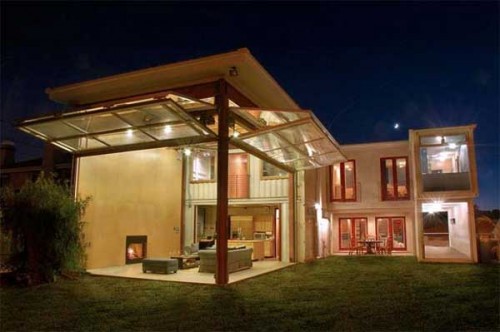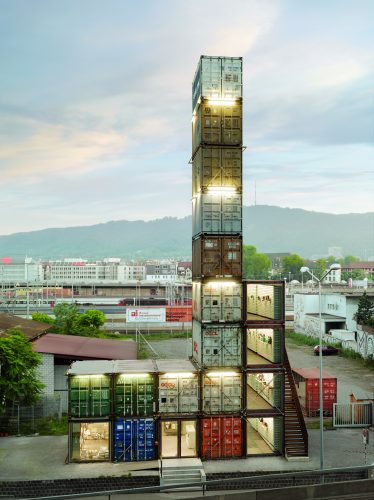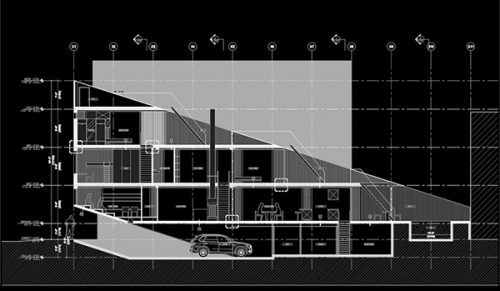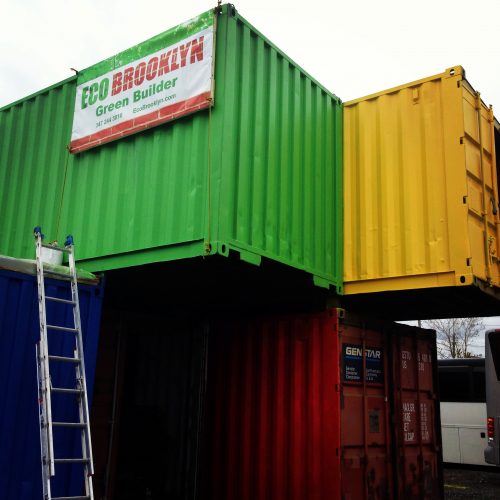If you are interested in green building, environmentalism, or architecture, chances are that you have seen some of the chic structures coming out of the shipping container building movement. These structures range from the Redondo Beach container home, which won an award for innovative design from The American Institute of Architects in 2007, to the 85 foot tall Freitag container structure located in Zurich.


Closer to home here in Brooklyn there are several container structures.


Although these buildings are architecturally interesting, the reasons container homes really shine in the eyes of Eco Brooklyn are more practical: environmental, cost, and function.
A container home is environmentally sound because it is the product of reused materials. As the economy ebbs and flows and as import and export changes, there inevitably are shipping containers that fall by the wayside to gather rust and eventually become scrap metal.
In terms of time savings, re-purposing a shipping container into a home allows the supporting structure along with the ceiling to come with almost no new production, resulting in large savings in lumber. This process also cuts down on the energy that would be required to turn a container into scrap metal before that metal is reused.
It should be noted though that the biggest mistake people make is underestimating the extra work a shipping container requires. To turn a metal box into a cozy home takes a lot of cutting, welding and drilling. Nonetheless if designed correctly a shipping container can be cheaper than a normal structure.
The modular nature of shipping container construction allows for building the modules in a large warehouse for example. This creates savings on production materials, labor hours, and carbon emissions in comparison to conventional on-site building. These advantages are gained through the ability of shipping container home construction to be carried out in a central location free of things like weather, site constraints and delivery issues.
This allows for the project manager to easily have materials shipped to the assembly location so there is no reason to buy more material than is necessary, which is common practice for on-site construction. The laborers can work in a climate controlled setting with all of the necessary tools readily available, and it is not necessary to move large quantities of people to an obscure job site every day.
Of course getting the modules to the final site is not always easy. But keep in mind these are shipping containers, designed to sit nicely on trucks, trains and boats.
Shipping containers are extremely functional when it comes to use as a pre-fabricated building material considering their low price (as low as $1500 per unit). These functional advantages include strength, availability, stackability, transport ease, speed, and addition ease. Shipping containers are used as heavy cargo carriers with the ability to be stacked upon one another on sea-going ships. This means that the containers are far stronger than what is necessary for a home.
Their modular nature also means that building does not have to be done all at once. You can build one container, then add another one later.
In port cities (most of the biggest cities are port cities) used shipping containers are readily available in all kinds of sizes and conditions. Even if you are not located in a port city, shipping containers are easily transported by truck. This allows for the use of shipping containers in very remote areas, like the Australian Outback, because they can be built where the work is and then easily transported to where the remote home may be located.
Shipping container construction is inherently fast. This is because t
he relatively small amounts of site work including foundation pouring and landscaping can be done simultaneously with the container construction. This allows for about 50% shorter construction time. Unlike conventional homes, container homes can be easily added onto without needing to make large changes to the existing structure since the modules are individually supported.
Shipping containers have some inherent disadvantages regarding their design and previous uses. Since steel conducts heat very efficiently shipping containers must be heavily insulated in extreme climates. There is nothing more uncomfortable than being in a steel box when it is cold or very hot.
Used shipping containers have possibly been filled with food spills, pesticides, and lead paint. When cargo crosses country borders it is common for the border patrol to spray the containers with pesticides to reduce cross country contamination of rodents and invasive plant species.
Because of this, the container needs to be cleaned thoroughly before conversion and in some cases it is necessary to remove the wood floor that they come with and seal or get rid of lead contaminated paint entirely.
Since shipping container architecture is new, another hurdle is acceptance by local building inspectors. Steel is an uncommon structural material for homes and it can be difficult to acquire a zoning permit and for the structure to pass building code.
Aside from some easily fixable inherent disadvantages with shipping containers, and one very difficult to deal with issue concerning zoning and building code, container homes create an elegant sector of green architecture. Companies like Intermodal Design are creating simple and affordable housing solutions by taking advantage of these structures.
Other companies like Container Home Consultants Inc., run by Alex Klein, are finding ways to help families help themselves by showing them the relative ease of DIY shipping container (ISBU) home building compared to conventional home construction.
Eco Brooklyn is a shipping container builder and we are experimenting with new ways to make the containers more habitable. One technique is covering the roofs with green roofs, reducing the heat in the summer. We also like berming two or even three sides of the container, much like in Earthship construction.
We are currently working on a shipping container music studio for a client in Brooklyn. The challenge there is soundproofing, since metal is not a great material for that. But we think a green roof, some berming and lots of sound deadening cellulose insulation will work just fine. We’ll keep you posted when that gets started.
